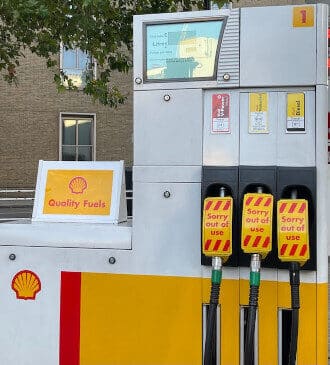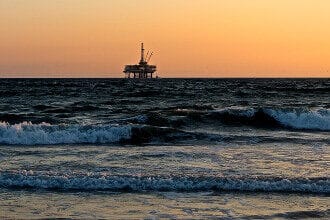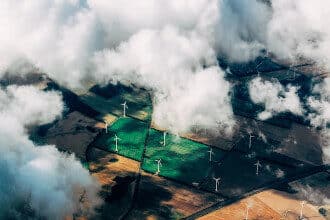By Ethel Mendius – The peak oil concept suggests that the world’s oil production will reach a maximum rate and then decline as oil reserves dwindle and extraction becomes difficult and costly. While scientists have not reached a consensus about peak oil, cautions about our oil consumption should be welcome in an era of climate crisis.
The Origins of Peak Oil Theory
In the 1950s, a researcher for the Shell Oil Company named Marion King Hubbert observed many instances in the United States where “oil production follows a bell-shaped curve”. In 1956, he presented a paper to the American Petroleum Institute that “hypothesized that U.S. petroleum production would peak between 1965 and 1975.”
Oil is a finite resource, “made up of hydrocarbons formed from the remains of animals and plants that lived millions of years ago.” Like other fossil fuel resources, it becomes harder to source as reserves are depleted.
In Hubbert’s peak oil theory, peak oil occurs when “the production decline accelerates” and the cost of oil extraction rises. In the 1970s, Hubbert extrapolated this research to a prediction that global production would peak in 2000.
Peak Oil And Oil Depletion
Peak oil is sometimes confused with oil depletion, a related concept that refers to the decline of oil reserves in a given region. However, economic factors, such as the demand for oil and the cost of production, could also cause oil to reach peak production.
The 1973 Oil Crisis
Hubbert’s peak oil theory gained prominence in 1973 with the oil embargo led by the Organization of Petroleum Exporting Countries (OPEC), which “exposed the United States’ vulnerability to a drop in oil supplies.” The resulting economic fallout drew national attention to oil production.
Since then, peak oil “has been a major concern for energy-dependent nations” seeking to maintain energy security. Countries like the United States are aware that a compromised oil supply would lead to rising fuel prices and other disastrous implications for the global economy.
Oil Production And Modern Technology
Over the course of the 20th century, peak oil theory seemed to prove correct: U.S. crude oil production “reached 9.6 million barrels per day in 1970 before decreasing through 2008.” However, oil companies have sought to avoid reaching peak oil, and government policies have been shaped to maintain independence from the global oil supply.
In practice, these concerns have led to investment in new technologies with results that defy the predictions of peak oil theory. 2008 marked the beginning of the U.S. Shale Revolution, which brought techniques such as hydraulic fracturing (fracking) and horizontal drilling to the forefront to reduce our reliance on conventional crude oil.
These methods instead give access to “unconventional oil”, which cannot be extracted using vertical drilling methods. Unconventional oil includes tight oil which is oil “trapped in geologic formations with low permeability”, bitumen which is “grains of sand enveloped by layers of water and heavy oil”, also known as asphalt and oil shale which is a rock containing “kerogen, a precursor to oil.”
Oil production in the U.S. has expanded vastly because of these newly accessible oil resources. The U.S. Energy Information Administration estimates that in 2021, crude oil production reached 11.185 million barrels per day, with 65% of that oil extracted “directly from tight oil resources” using fracking.
For more than a decade, this technology has served to reduce oil prices in the U.S. with knock-on effects in the global energy sector. Daniel Raimi, a researcher at Resources for the Future, writes that “cheaper energy encourages people to use more energy” and the Shale Revolution has motivated further global oil production.
The Environmental Impact of Oil Production
The above figures rebuff the notion that the U.S. has reached peak oil, at least in terms of supply, and modern drilling techniques have been adopted by other oil producers across the globe. However, environmental factors give us a reason to predict, and encourage, a decline in oil production.
Oil is well-known as a fossil fuel, and when burned it releases carbon dioxide that contributes to global warming. Recent estimates suggest 89% of carbon dioxide emissions come from “fossil fuels and industry,” which includes oil, coal, natural gas. Oil accounts for “approximately a third of the world’s total carbon emissions.”
Global warming is the preeminent risk of our times. If the global temperature increases above 1.5° Celsius, we risk “further sea level rise, extreme weather, biodiversity loss and species extinction” that will prove disastrous to human life. The health of the planet necessitates we reduce carbon dioxide emissions by curbing our oil production.
Like other fossil fuels, oil is known to contribute to air, water, and soil pollution that threaten both human and animal life. Drilling for oil disrupts local wildlands and habitats, and “the damage is often irreversible”.
In addition, oil production contributes to environmental disasters. In 2010, the British Petroleum Deepwater Horizon oil spill killed 11 people and “dumped more than 200 million gallons of crude oil into the Gulf of Mexico, leading to a wave of wildlife deaths.”
Reaching Peak Oil Demand
Environmental concerns contributed to a decline in world oil production witnessed in recent years. In 2020, the oil industry faced a triple threat; “the politics of decarbonization, lifestyle changes stimulated by the pandemic, and the rapid rollout of green technologies” led to a 9% decline in global demand.
This scenario offers a revised model of peak oil; if consumption patterns change, we could bring about peak oil regardless of the reserves at our disposal.
Sustainability researcher Mark Lewis cited three trends reasons that may lead to a decline in oil demand: “decarbonization of economies to meet the Paris climate agreement; deflation of demand as renewable energy sources and electric vehicles kick in; and ‘detoxification’ as cities curb particulates and nitrogen oxide emissions from burning petroleum.”
The emergence of these trends indicates that global oil production would peak if crude oil becomes a less profitable venture than other energy sources, and if policies were shaped to prioritize energy efficiency over economic growth.
Making this transition requires a commitment to cost-effective energy efficiency.
The Environmental Protection Agency advocates for a National Action Plan for Energy Efficiency that would “reduce energy use, save billions on customer energy bills, and reduce the need for new power supplies.”
Alternative Energy Sources
In order to reach peak oil demand and inhibit future production, we must invest in renewable energy sources to meet our needs. World oil production continues to expand because we have chosen to rely on crude oil as our primary energy source.
The geopolitical instability seen in 2022 because of the war in Ukraine has demonstrated that we cannot rely on oil as fuel. Journalist Eric Rosenbaum writes, “society should recognize the need for more sources of energy, and especially the need for more sources of clean energy.”
Clean energy reaps many benefits. In addition to reducing our carbon footprint and pollution, investing in wind and solar energy “provide[s] a vast and constantly replenished supply of energy”, benefitting our economies and societies. A recent study conducted by the U.S. Department of Energy “found that renewable energy could comfortably provide up to 80 percent of US electricity by 2050.”
These changes would facilitate a declining demand for oil and a greener future for our planet. While peak oil theory has not played out as Marion King Hubbert imagined, we can hope to see its continued relevance in our times.
Religion And Oil
Genesis 14:10 – Now the Valley of Siddim Was Dotted with Bitumen Pits; and the Kings of Sodom and Gomorrah, in Their Flight, Threw Themselves Into Them, While the Rest Escaped to the Hill Country.
Stuck In Crude Oil From Eco Bible Volume 1
The kings of Sodom and Gomorrah fell into pits of “black gold” or bitumen (in Hebrew, Chemar). In ancient times as today, surface seepages of this thick, sticky form of crude oil occurred and still occur in a limited number of places in the world, including Azerbaijan, Iran, Pennsylvania, Alberta, and the Dead Sea. People used and still use the natural tar for its waterproofing qualities and for roads.
Why does the Torah mention this geological detail in relation to the leaders of these ultimately decimated societies? The Torah continues, “The invaders [four Middle Eastern kings] seized all the wealth of Sodom and Gomorrah and all their provisions, and went their way.” Once the kings of Sodom and Gomorrah fell into the bitumen pits, they got trapped and lost all of their wickedly gained wealth.
The story of the kings stuck in bitumen relates deeply to our world today. Canada is the planet’s fourth-largest oil producer, with 60 percent of its oil produced from the bitumen of oil sands. The Canadian province of Alberta has most of the world’s reserves of natural bitumen in the Athabasca oil sands, an area larger than England. Bitumen is considered the dirtiest and most polluting fossil fuel, due to the energy required to separate the crude oil from the sand and the carcinogenic chemicals used to thin it for pipeline transport.
Today, we and our leaders are trapped by economic inertia and political resistance. Oil remains our fuel of choice to make gasoline for cars and trucks, jet fuel for airplanes, tar and asphalt for paving the roads, and even plastic which is filling our oceans with trash that never fully breaks down.
The Midrash teaches that Abraham, the prophet of light, pulled the kings out of the bitumen pits. Abraham provides an example of lifting people from being trapped in fossil fuels. Comparatively, scientists published a 2017 study and environmental roadmap on how most countries in the world could transition to 100 percent wind, water, and solar energy by 2050.
We do not need to wait until someone rescues us – or until we run out of all fossil fuels. Instead, we can take steps now as individuals, communities, and nations to free ourselves from devastating fossil-fuel use.
* Featured image source





